The First Socialist City

When the Soviet Union was founded, the first Five Year Plan from 1928 projected the rapid urbanisation and industrialisation of Russia. Mount Magnita, in the foothills of the Ural, was known to consist of almost pure iron ore, and because of its strategic location in the middle of the new nation, a giant steel mill was built into the vast emptiness of the west-sibirian steppe that would become one of the biggest in the world. The city to house the thousands of newly arrived workers was named Magnitogorsk - the "village by the magnetic mountain".
It was a city built completely from scratch. Ernst May, progressive city planner from Germany, architect, and next to Le Corbusier one of the founding members of the CIAM, was commissioned to develop the plan. Magnitogorsk should become the blueprint of the ideal socialist city (Russian: Sotsgorod), by being organized completely by the idea of productivism: the linearity of the conveyor belt should be continued into the kitchens and bedrooms of the workers and by that change the organization and structure of society as a whole. The principles of socialistic city planning, worked on by May and his team, were basically in line with the ones developed by western European urban Modernism: functional seperation between housing, work, and recreation with efficient transport connections. The high number and spacial distribution of theaters and cultural centers, where people could meet after work for leisure and education, but especially the multitude of kindergardens, schools, canteens and laundries made it clear, that Magnitogorsk was not only planned to be a mono-industrial city but rather a cultural, civilizing project. A majority of apartment houses had bedrooms and bathrooms, but no kitchens or living rooms. Behind this stood the idea to free the (working class) woman from domestic and reproductive labor and to dissolve the (bourgeoise) nuclear family in favor of a more flexible model of inter-personal relationships.
Today, Mount Magnita has been extracted completely - it was turned into steel and only an immense empty pit remains where it once stood. Although now privatized, the steel mill still operates and runs around the clock. According to the company's 2015 annual report, it has 18.500 employees - less than a third of the more than sixty thousand who worked there in 1990. Unemployment ranks at about 13 percent. Magnitogorsk's earth and air is polluted enough to rank on the United Nations' list of the world's "Most Altered Environments". Until today, thirty percent of the babies born here are sick. Tests of air and drinking water result in high residues of lead, sulfur dioxide and other heavy metals.
But can these facts be of help to get an idea of Magnitogorsk?
Since the beginning of Magnitogorsk, one, two, three, in some cases even four generations of people have lived in this city; who once came from somewhere else to build up a new, utopian society; who lived through one, two, three political systems; who have lived in a so-called Strategically Closed City, where the cinemas screened Big City Nights until The Scorpions' Wind of Change reached even behind the Urals.
See my story about Magnitogorsk in The Guardian.

"Magnitogorsk - where Europe and Asia meet" is the city’s official slogan.
The Ural river divides the city into eastern and wester parts. The original "socialist city" or Sotsgorod, and the gigantic steel mill complex of the Magnitogorsk Metallurgic Kombinat, which was once one of the largest in the world, are located in the east. Newer districts built after the "Great Patriotic War" are lying to the west. Here, the so-called Cossack village — the only district with single family houses — can be seen in the foreground, and beyond it the golden domes of the Cathedral of the Holy Ascension, which stands a monument to the resurgence of the Orthodox church after the end of the Soviet Union.


While official life takes place in the cities' West these days – the university, the opera houses, theaters and cinemas, the new mega-church, shopping areas and the city hall are located there – time seems to be standing still in the East. It comes down to the expectable clichees of urban periphery: Plaster peeling from the walls. The park areas between the houses overgrow. Old cars without engines between bushes. Children play on the compound of a demolished building, that no investor is interested to buy.

Everyday commodities are offered in the little shops in the ground floors of apartment buildings and at the three, four market stalls by the big crossing where the tram lines meet. For everything else one has to cross one of the three bridges to the West of Magnitogorsk.

The planning principles from which the socialist city model was derived were largely similar to those animating European modernist architecture of the 1930s: cities were to be organized by functional separations between comfortable housing, industrial work, and restorative recreation provided by green space and cultural institutions, all connected by fast, efficient transportation infrastructure. In interpreting these concepts for the Soviet context, planners of the Sotsgorod placed special emphasis on communal institutions that consolidated domestic labor into industrial-scale laundries, modern childcare facilities, workers clubs, and "super kitchens" feeding the workers en masse.

Older women, many of whom are retired from jobs in the mill and its supporting industries, sell produce grown in the gardens of their datchas in rows of little market stalls set up in squares and on sidewalks in western Magnitogorsk.

With an eye to the consolidation of social life and domestic functions many apartments were planned without kitchens or living rooms. This was motivated not only by a concern for efficiency but also by the desire to free working women from housework and reproductive labor. The aim of the laundries, canteens and kindergartens spread throughout the Socialist City was to advance the emancipation of women by freeing their time, both for productive work and personal development.


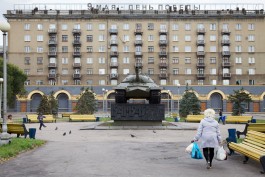
Later in the 1930s, with the Sotsgorod still under construction, the official opinion of the emerging Stalinist regime would turn against Modernist architecture and many of the ideals by which it was informed. Housing construction and urban development would largely cease during the war years, and after the war new construction would be stylistically marked by the heroically-scaled neoclassicism of Socialist Realism.

Now privatized, and undergoing an ongoing process of modernization, the steel mill still operates around the clock. When the Soviet Union ended, Magnitogorsk's earth and air was polluted enough to earn the city a place on the United Nations' list of the world's "Most Altered Environments". Today the air and drinking water are still contaminated with high levels of lead, sulfur dioxide and heavy metals. Scrubbers have however been installed on the mill’s towering smokestacks and a program of bioremediation is underway at the pit from which iron ore was mined during the city’s early years. These and other measures have had a marked effect on environmental conditions and, with them, the quality of life in Magnitogorsk.
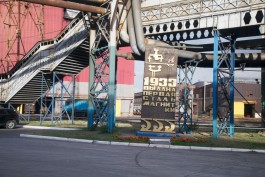

One of the old blast furnaces and the giant galvanisation hall at the steel mill.

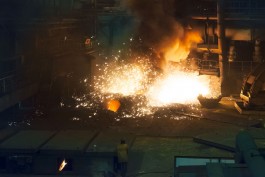
It's a spectacle, when the liquid iron is literally spit out of the blast furnace once the smelting process is finished. The procedure is repeated every two hours.
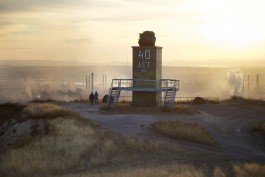
After the iron ore was completely extracted and the mountain turned into a vast empty pit in the beginning of the 1970s, one of the shovels was turned into a monument at the edge of the pit.


Today, the history of the Soviet Union and the development programs undertaken by successive regimes of government leadership, can be read in the different types of construction along Magnitogorsk’s two North-South axes, Karl Marx Street and Lenin Street. Stalin gave the city “workers’ palaces” ornamented with neoclassical stucco work. Chruschev built solid, low-cost apartment buildings of three to five stories in prefabricated concrete modular construction. Brezhnev added more comfortable, but more shoddily constructed, prefab concrete slab buildings with elevators and better insulation. Gorbachev and perestroika would bring high-rise apartment buildings surrounded by spacious park areas, and now under Putin shopping malls and big-box retail have come to the city by the magnetic mountain.

Members of the department of pedagogy.

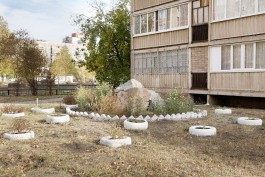
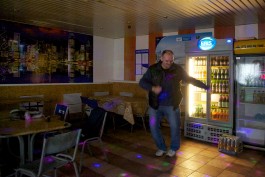

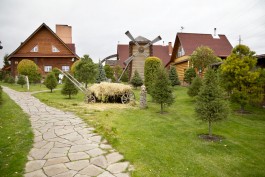
The local sauna village. Over time, the russian word "banya" changed it's meaning from public bathhouse to sauna.

This chicken coop by the fence of the sauna village is nostalgic for a folkloric past that never actually existed in Magnitogorsk.

The Holy Ascension Cathedral is one of the biggest new church constructions in Russia.

Where Lenin once greeted the workers at the factory gates, a new statue made of plastic containers now points the way to a car-repair shop.


The First Socialist City

When the Soviet Union was founded, the first Five Year Plan from 1928 projected the rapid urbanisation and industrialisation of Russia. Mount Magnita, in the foothills of the Ural, was known to consist of almost pure iron ore, and because of its strategic location in the middle of the new nation, a giant steel mill was built into the vast emptiness of the west-sibirian steppe that would become one of the biggest in the world. The city to house the thousands of newly arrived workers was named Magnitogorsk - the "village by the magnetic mountain".
It was a city built completely from scratch. Ernst May, progressive city planner from Germany, architect, and next to Le Corbusier one of the founding members of the CIAM, was commissioned to develop the plan. Magnitogorsk should become the blueprint of the ideal socialist city (Russian: Sotsgorod), by being organized completely by the idea of productivism: the linearity of the conveyor belt should be continued into the kitchens and bedrooms of the workers and by that change the organization and structure of society as a whole. The principles of socialistic city planning, worked on by May and his team, were basically in line with the ones developed by western European urban Modernism: functional seperation between housing, work, and recreation with efficient transport connections. The high number and spacial distribution of theaters and cultural centers, where people could meet after work for leisure and education, but especially the multitude of kindergardens, schools, canteens and laundries made it clear, that Magnitogorsk was not only planned to be a mono-industrial city but rather a cultural, civilizing project. A majority of apartment houses had bedrooms and bathrooms, but no kitchens or living rooms. Behind this stood the idea to free the (working class) woman from domestic and reproductive labor and to dissolve the (bourgeoise) nuclear family in favor of a more flexible model of inter-personal relationships.
Today, Mount Magnita has been extracted completely - it was turned into steel and only an immense empty pit remains where it once stood. Although now privatized, the steel mill still operates and runs around the clock. According to the company's 2015 annual report, it has 18.500 employees - less than a third of the more than sixty thousand who worked there in 1990. Unemployment ranks at about 13 percent. Magnitogorsk's earth and air is polluted enough to rank on the United Nations' list of the world's "Most Altered Environments". Until today, thirty percent of the babies born here are sick. Tests of air and drinking water result in high residues of lead, sulfur dioxide and other heavy metals.
But can these facts be of help to get an idea of Magnitogorsk?
Since the beginning of Magnitogorsk, one, two, three, in some cases even four generations of people have lived in this city; who once came from somewhere else to build up a new, utopian society; who lived through one, two, three political systems; who have lived in a so-called Strategically Closed City, where the cinemas screened Big City Nights until The Scorpions' Wind of Change reached even behind the Urals.
See my story about Magnitogorsk in The Guardian.

"Magnitogorsk - where Europe and Asia meet" is the city’s official slogan.
The Ural river divides the city into eastern and wester parts. The original "socialist city" or Sotsgorod, and the gigantic steel mill complex of the Magnitogorsk Metallurgic Kombinat, which was once one of the largest in the world, are located in the east. Newer districts built after the "Great Patriotic War" are lying to the west. Here, the so-called Cossack village — the only district with single family houses — can be seen in the foreground, and beyond it the golden domes of the Cathedral of the Holy Ascension, which stands a monument to the resurgence of the Orthodox church after the end of the Soviet Union.


While official life takes place in the cities' West these days – the university, the opera houses, theaters and cinemas, the new mega-church, shopping areas and the city hall are located there – time seems to be standing still in the East. It comes down to the expectable clichees of urban periphery: Plaster peeling from the walls. The park areas between the houses overgrow. Old cars without engines between bushes. Children play on the compound of a demolished building, that no investor is interested to buy.

Everyday commodities are offered in the little shops in the ground floors of apartment buildings and at the three, four market stalls by the big crossing where the tram lines meet. For everything else one has to cross one of the three bridges to the West of Magnitogorsk.

The planning principles from which the socialist city model was derived were largely similar to those animating European modernist architecture of the 1930s: cities were to be organized by functional separations between comfortable housing, industrial work, and restorative recreation provided by green space and cultural institutions, all connected by fast, efficient transportation infrastructure. In interpreting these concepts for the Soviet context, planners of the Sotsgorod placed special emphasis on communal institutions that consolidated domestic labor into industrial-scale laundries, modern childcare facilities, workers clubs, and "super kitchens" feeding the workers en masse.

Older women, many of whom are retired from jobs in the mill and its supporting industries, sell produce grown in the gardens of their datchas in rows of little market stalls set up in squares and on sidewalks in western Magnitogorsk.

With an eye to the consolidation of social life and domestic functions many apartments were planned without kitchens or living rooms. This was motivated not only by a concern for efficiency but also by the desire to free working women from housework and reproductive labor. The aim of the laundries, canteens and kindergartens spread throughout the Socialist City was to advance the emancipation of women by freeing their time, both for productive work and personal development.



Later in the 1930s, with the Sotsgorod still under construction, the official opinion of the emerging Stalinist regime would turn against Modernist architecture and many of the ideals by which it was informed. Housing construction and urban development would largely cease during the war years, and after the war new construction would be stylistically marked by the heroically-scaled neoclassicism of Socialist Realism.

Now privatized, and undergoing an ongoing process of modernization, the steel mill still operates around the clock. When the Soviet Union ended, Magnitogorsk's earth and air was polluted enough to earn the city a place on the United Nations' list of the world's "Most Altered Environments". Today the air and drinking water are still contaminated with high levels of lead, sulfur dioxide and heavy metals. Scrubbers have however been installed on the mill’s towering smokestacks and a program of bioremediation is underway at the pit from which iron ore was mined during the city’s early years. These and other measures have had a marked effect on environmental conditions and, with them, the quality of life in Magnitogorsk.


One of the old blast furnaces and the giant galvanisation hall at the steel mill.


It's a spectacle, when the liquid iron is literally spit out of the blast furnace once the smelting process is finished. The procedure is repeated every two hours.

After the iron ore was completely extracted and the mountain turned into a vast empty pit in the beginning of the 1970s, one of the shovels was turned into a monument at the edge of the pit.


Today, the history of the Soviet Union and the development programs undertaken by successive regimes of government leadership, can be read in the different types of construction along Magnitogorsk’s two North-South axes, Karl Marx Street and Lenin Street. Stalin gave the city “workers’ palaces” ornamented with neoclassical stucco work. Chruschev built solid, low-cost apartment buildings of three to five stories in prefabricated concrete modular construction. Brezhnev added more comfortable, but more shoddily constructed, prefab concrete slab buildings with elevators and better insulation. Gorbachev and perestroika would bring high-rise apartment buildings surrounded by spacious park areas, and now under Putin shopping malls and big-box retail have come to the city by the magnetic mountain.

Members of the department of pedagogy.





The local sauna village. Over time, the russian word "banya" changed it's meaning from public bathhouse to sauna.

This chicken coop by the fence of the sauna village is nostalgic for a folkloric past that never actually existed in Magnitogorsk.

The Holy Ascension Cathedral is one of the biggest new church constructions in Russia.

Where Lenin once greeted the workers at the factory gates, a new statue made of plastic containers now points the way to a car-repair shop.

